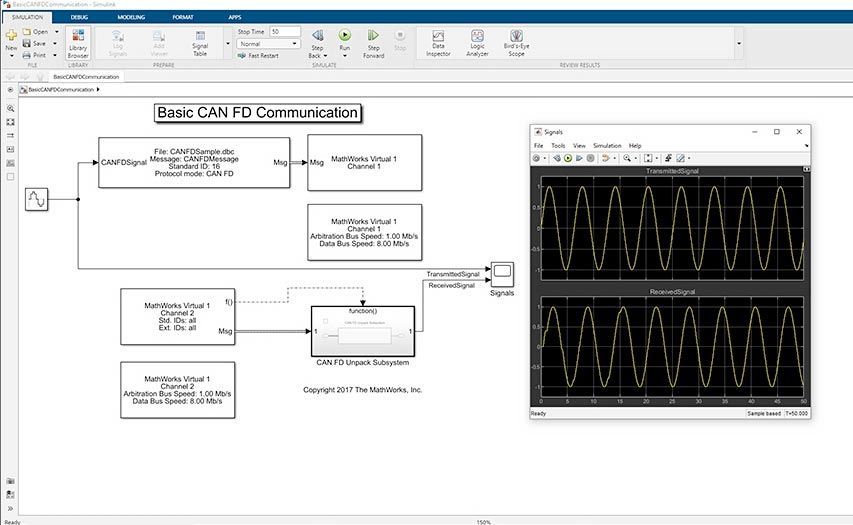The MATLAB environment for analysis provides the tools you need to acquire data and automate tasks. Within MATLAB and Simulink you can control and acquire data from plug-in data acquisition boards, test instruments, Web cameras and frame grabbers, as well as send and receive messages over CAN buses.
Once you acquire data, you can interactively explore it and perform live visualization and data analysis. You can then build test systems, verify designs and concepts, and automate repetitive tasks. You can also deploy test applications built in MATLAB onto other computers.
“It used to take us weeks to identify the interference source. With MATLAB, we can now identify and resolve noise and interference problems in a matter of hours.”
Communicating with Hardware and Instruments
Using MATLAB or Simulink and related products, you can control and acquire data from data acquisition hardware, imaging hardware, instruments, or CAN buses. You can also communicate with circuit boards and sensors using SPI (Serial Peripheral Interface), I2C (Inter-Integrated Circuit), and Modbus protocols. Without leaving your workspace, you can then visualize and analyze the data.
Acquire and Send Data from Test and Measurement Equipment
In a single environment, you can build flexible test systems, automate testing routines, perform design verification, and analyze and visualize live data as you collect it.
When working with one or more standalone instruments such as oscilloscopes, arbitrary waveform generators, and signal analyzers, you use Instrument Control Toolbox to control the instruments and acquire data from them. You can quickly establish communication with instruments via industry-standard communications protocols such as GPIB, VISA (incuding USB), TCP/IP, and UDP and via industry-standard instrument drivers such as IVI and VXIplug&play. Multiple instrument manufacturers are supported including Keysight, Rohde & Schwarz, and Tektronix. You can also build test systems based on LXI, PXI, and AXIe standards.
When working with plug-in data acquisition boards, you connect to supported boards from multiple vendors using Data Acquisition Toolbox. Because many boards provide both analog and digital input and output capabilities, you can control motors and sensors as well as collect and analyze live data.


Acquire and Send Data Using I2C, SPI, and Modbus Protocols
With Instrument Control Toolbox, you can connect MATLAB to devices that communicate over I2C and SPI. You can send and receive messages using these protocols and you can build applications that interface to embedded sensors such as accelerometers, temperature sensors, humidity sensors, and gyroscopes. You can also perform generic testing of embedded systems that communicate via SPI or I2C.
With Industrial Communication Toolbox, you can communicate with industrial equipment and sensors using protocols such as OPC UA, Modbus RTU, Modbus TCP/IP, and MQTT. You can also exchange data with Pi servers.
Acquire Images and Video from Cameras and Frame Grabbers
With Image Acquisition Toolbox you can acquire images and video directly into MATLAB and Simulink from PC-compatible imaging hardware. With support for multiple hardware vendors, you have the choice of a range of imaging devices from inexpensive Web cameras or industrial frame grabbers to high-end scientific cameras that meet low-light, high-speed, and other challenging requirements. Once you have acquired images, you can extract features and perform further analysis using MathWorks image and video processing products.


Communicate Directly with CAN Buses and Analyze Automotive Test Data
With Vehicle Network Toolbox you can monitor and analyze Controller Area Network (CAN) bus traffic directly from your MATLAB or Simulink workspace with support for Vector, Kvaser, NI-XNET, and PEAK-System interface hardware. You can communicate directly with in-vehicle networks using CAN protocol and XCP protocol from either MATLAB or Simulink. You can also import and decode data stored in MDF and BLF files for further analysis in MATLAB. The toolbox facilitates the following workflows in MATLAB and Simulink.
- Sending and receiving messages over CAN and XCP protocols
- Monitoring live CAN and CAN FD bus traffic using built-in tools
- Automatically filtering CAN messages
- Working with industry standard DBC, A2L, ARXML, MDF, and BLF files
Analyzing Your Test Data
Once you have acquired the data, you can use analysis and visualization tools in MATLAB and related data analysis products. Acquiring and analyzing the data in the same environment lets you quickly extract the information you need from your data. Using interactive tools and command-line functions, you can perform tasks such as signal and image processing, statistical analysis, digital filtering, curve fitting, and nonlinear optimization. In addition, you can build graphical interfaces for data acquisition and live analysis of your test data.
When working with acquired data, you can use digital filtering routines to focus on the signal or feature of interest and easily view time-domain data in the frequency domain. When working with image data, you can restore noisy or degraded images and analyze shapes and textures. For projects that involve acquiring data repeatedly, you can investigate the statistics of a phenomenon over time.


Automating Tests and Building Test Applications
Using the capabilities of MATLAB, you can automate your test system to simplify your data collection and analysis. You can build test systems based on LXI, PXI, and AXIe standards. You can build applications with graphical interfaces, and share these applications with others using MATLAB. You can also use MathWorks desktop and Web deployment products to deploy test applications built in MATLAB onto other computers.
Customer Success
Explore Products

